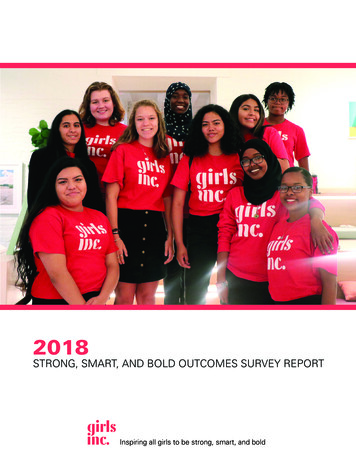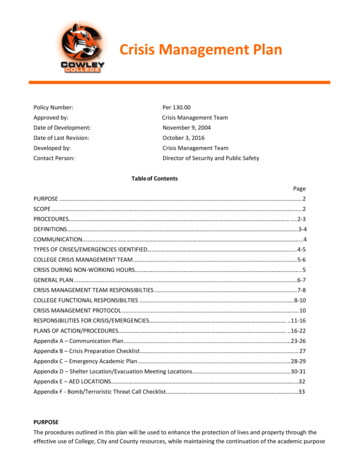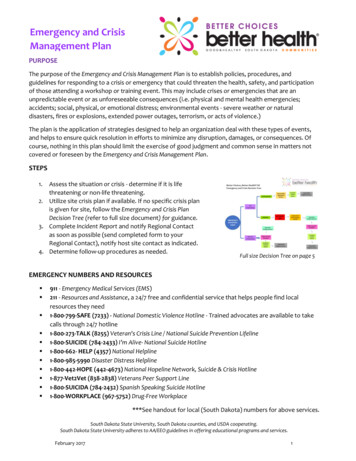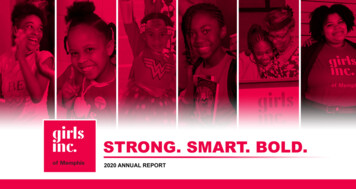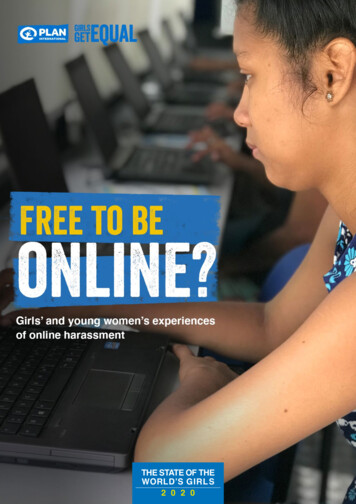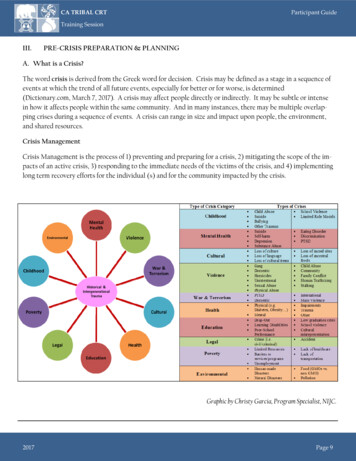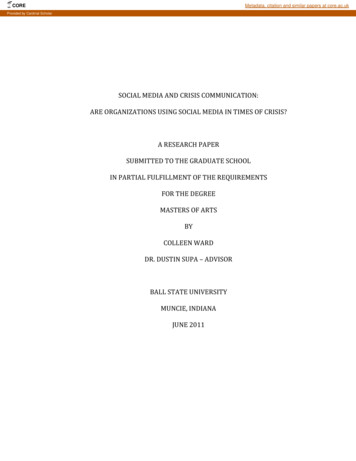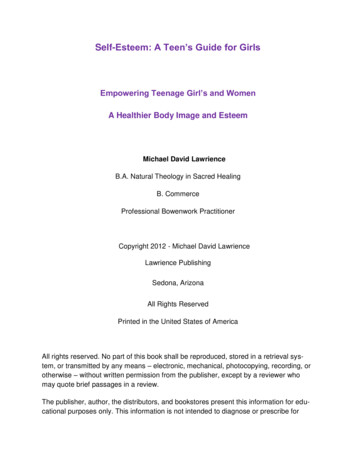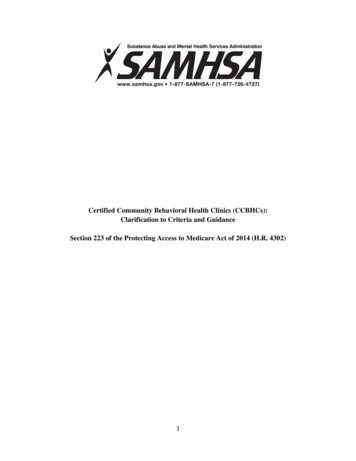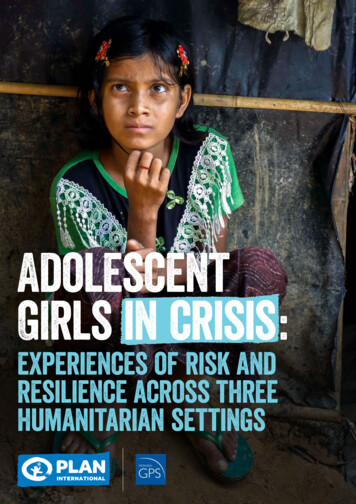
Transcription
AdolescentGirls in crisis:experiences of risk andresilience across threehumanitarian settings
Adolescent girls living throughthese three long-term crises faceparticular challenges in differentlocations. However, their lives andexperiences also illuminate therisks encountered and the courageshown by girls and young womendealing with similar situations allover the world.2plan-international.org
Adolescent Girls in Crisis:Summary of findings andrecommendationsAdolescent Girls in Crisis is a research projectinformed by and centred upon the voices andexperiences of girls in three of the world’s mosttroubled and volatile locations: South Sudan,the Lake Chad Basin and the Rohingya refugeecamps in Bangladesh.Nyiel writing in her notepad in Baratukuresettlement camp in Uganda.( Plan / Rose Sjölander)The research found that:Girls Livein FearGirls’ Livesare RestrictedGirls Want togo to SchoolAdolescent girlstold us of the fearcaused not onlyby the constantpresence ofarmed men, butabout genderbased violencewithin families,including child,early and forcedmarriage, whichputs their health,their education andgeneral well-beingat risk.Adolescent girlslack freedom ofmovement: overprotective parents,a heightened fearof violence andincreased domesticchores confinethem to the homeand severely limittheir opportunities.Adolescent girlscannot go toschool, they cannotmake friends andthey cannot contacthealth services.Adolescent girlseverywhereexpress a passionfor study and adisappointmentthat their currentsituation, oftencombined withpre-existingdiscrimination,prevents them fromattending school orgaining access tovocational training.Fear keeps themat home, as doesfamily poverty, butoften also thereare no schools ortraining centres forthem to go to, theyare too far away orthey have missedso much educationthat they struggleto catch up.Girls Struggleto Stay Healthy,Both Physicallyand MentallyGirls Want MoreControl andPower OverTheir LivesAdolescentgirls lack propernutrition, havelittle or no accessto informationabout sexualand reproductivehealth, and,particularlyin the area ofmental health,have extremelyrestricted accessto health services.All of which willhave a long termdestructive impacton their lives.The inability tocontrol their livesto be consultedabout decisionsthat affect themis reflected on byadolescent girls inall three researchareas: adolescentgirls cannot chooseto carry on withtheir education, orwhether, when orwhom to marry, norare they able topursue livelihoodopportunities thatmight give thema measure ofindependence.What needs to be doneThe following recommendations are based on what adolescent girls have told us about their experiencesand their priorities for the future: Increase participation of adolescent girls in decision making Ensure adolescent girls’ education does not suffer Prioritise provision of adolescent girl-friendly health information and services, to include mental healthissues and sexual and reproductive health and rights Tackle gender-based violence in all its forms to improve security for adolescent girls.plan-international.org3
Lessons fromthree major crisesEverybody caught up in war, famine, flood, or anyother emergency situation has their lives torn apart,but none more so than adolescent girls. Pre-existinggender inequalities are exacerbated in all crisesand adolescent girls’ physical safety, their healthand their future prospects are all threatened in waysthat differ from the risks faced by younger girls andboys, or by men, adolescent boys and adult women.Often, too, just because they are young and female,their rights and needs are ignored.“I want to go to school, to read lots of books.I want to play.”ROHINGYA GIRL,10, BANGLADESHA long-term crisis may well last throughout a girl’sformative years and this ongoing disruption tonutrition, education, or knowledge building aroundissues such as sexual and reproductive healthand rights can have life-long effects.1 Additionally,prolonged poverty, combined with entrenchedgender discrimination, can make girls especiallyvulnerable to trafficking, sexual exploitation andchild, early and forced marriage.2 Even if thecrisis ends they can be left traumatised, with littleeducation or chance of paid employment, andoften with several children. Decisions taken for themduring adolescence will change their lives forever.“Enrol us in schools, provide skills acquisition,provide basic amenities (hospitals, electricity, water)so as to help us live our lives better and easier.”GIRL, 13, LAKE CHAD BASINAdolescent Girls in Crisis is informed by andcentred upon the voices and experiences of girlsin three of the world’s most troubled, and volatilelocations: South Sudan, the Lake Chad Basin andthe Rohingya refugee camps in Bangladesh. Theresearch reflects the diversity of the needs andexperiences of adolescent girls - they are not ahomogenous group only defined by age - as wellas on what they may have in common. Not onlydo girls have the right to be consulted about theirneeds and prioritiesbut a better understanding of theways in which adolescent girls, in several differentcontexts, navigate ongoing crises will provide asolid basis for the humanitarian sector to work withthem to improve their lives. By seeking out theusually unheard-voices of girls and young womenin crises, our research project seeks to provide thisunderstanding; focusing not just on areas of concernfor adolescent girls, but also on the positive ways inwhich they respond to their circumstances and striveto support their communities.“Girls are not supposed to talk in front of elders,some of their issues never get addressedbecause of this, stopping them from participatingin the community the way that boys can.”NGO WORKER, JUBA, SOUTH SUDAN“My parents will force me to get married. I havenothing to do. They could not do it in Burma butcan do it here.”YOUNG ROHINGYA WOMAN, 18, BANGLADESHDespite the large numbers of adolescent girls soprofoundly affected by ongoing crises around theworld, it is rare that either their own communities,national governments or the humanitarian sectorat large, pay much attention to them: girls’ rightsin a crisis situation are not seen as a priority norare their particular needs, or their rights underinternational law, recognised and addressed. Thisresearch, commissioned by Plan International, is anattempt to rectify that: to acknowledge that girls, asthey enter and move through adolescence, do haveparticular challenges to face, they do have rights,and that their ideas about how to improve theirlives today and tomorrow are worth listening to andacting upon.Girl cooks inside her shelter inBalikhali camp, Cox’s Bazar (Bangladesh).( Plan International)Find all the reports at ional.org
Research Locations: Background and HistoryThe Rohingyacommunity inBangladeshThe Rohingya have beenpersecuted in Myanmar fordecades but in August 2017the crisis escalated afteran outbreak of violence inRakhine state - almost amillion Rohingya were forcedto flee Myanmar and nowlive in refugee camps inCox’s Bazar in neighbouringBangladesh.52%of the refugeepopulation arewomen and girls35560%South SudanNow half a decade long,the conflict in South Sudanhas displaced four millionpeople, one in three SouthSudanese, and placed sevenmillion in need of humanitarianassistance.7Almost2Mwomen and girls are at risk ofgender-based violence851%66%of thepopulationare under theage of 189of thepopulationare under theage of 3010of refugees are children4of the4%of the refugeepopulation arechild-headedhouseholds567%of the estimated 58,700pregnant women in thecamps have no access togynaecological or obstetrichealth care. 6plan-international.org4 000 000displaced, over half (2.4 million)are under the age of 18 112.5mare seeking refuge inneighbouring countries.12Lake Chad BasinThe crisis affecting the LakeChad Basin is one of themost severe humanitarianemergencies13 in the world,having displaced more than2.2 million people, half ofwhom are children, and leftmore than 10.8 million peoplein need of humanitarianassistance across northeast Nigeria, Cameroon’sfar north, western Chad andsouth-east Niger. The conflicthas been characterised byrampant levels of genderbased violence and violenceagainst children, with forcedrecruitment of child soldiersa significant concern. Thecombination of the statisticson maternal deaths and theincrease in child marriagerates illustrates the particularadverse effects the crisis ishaving on girls and youngwomen.In Niger, rates of child earlyand forced marriage arealways high; but in the regionof Niger most affected by thecrisis, rates are the highestin the world:89%of girls marryas children14the Lake Chad Basinhas one of the highestratios of maternaldeaths anywhere inthe world:15773.4per 100,000live births5
MethodologyResearch among the Rohingya community wasconducted in Balukhali Camp in Cox’s Bazar;amongst the displaced South Sudanese populationresearch was carried out in five sites in SouthSudan and in five sites in Uganda; in the LakeChad Basin research was conducted in elevensites infar north Cameroon, seven in north-eastNigeria and seven in south-east Niger.Sarah, 16, lives with her younger brother andmother in South Sudan. She is responsible forgrowing all the food her family need to survive.( Kate Holt / Plan International)What Did We Wantto Find Out?The research explores how adolescent girlswithin two age brackets (10-14 and 15-19years old) understand the unique impact thatcrisis has had upon them. It seeks to amplifytheir voices and perceptions of the crisis andpresent their views on how the humanitariansector might respond. It is driven by threemajor questions:01How do adolescent girls understandand experience insecurity?02How do adolescent girls navigateinsecurity?03What are their needs and whatopportunities exist to supportadolescent girls in protracted crisissituations?It is important to note that this research projectis not designed to establish the prevalenceof any particular issue, nor is it an objectiveaccount of adolescent girls’ experiences.The findings in this project are subjective andunderscore the fact that adolescent girls donot have a single view or set of experiencesin crisis contexts. However, the projectdoes highlight areas of both similarity anddifference across countries, crises and agegroups and provides a rich understanding ofadolescent girls’ experiences.6The research used mixed methods with an emphasison qualitative research: it comprised of single sexdiscussion groups of adolescent girls (6-10 participants)and some groups of boys, in all locations. Thegroups were split according to age: 10-14, 15-19.Researchers also conducted a number of indepth interviews with adolescent girls, communityleaders, members of civil society organisations andNGOs. In discussions with girls and young womencare was taken to use young, female interviewerswith whom they would feel comfortable.We also used a quantitative household surveywith adolescent girls in order to cross-referencefindings in interviews and focus group discussions.A total of 998 surveys (300 Rohingya, 249 fromSouth Sudan, 449 from the Lake Chad Basin) werecarried out across the three research areas.The project places the voices of adolescent girlsat the centre of its methodology. This approachallows adolescent girls a safe space to speakabout their lives: it makes adolescents authoritativein discussions regarding their own welfare and inunderstanding their social, political and economiccontexts. It means adolescent girls are both thesource of knowledge and the primary analyst oftheir lives and experiences.The methodology adopted in this research hasfive isttheoryplan-international.org
What the researchtells us aboutadolescent girlsin crisisDespite the different contexts and cultures of theadolescent girls taking part in the research theyhave a lot in common. Everywhere girls and womenwield less power in their families and communitiesthan boys and men: girls are valued less than boys,and, in troubled times, the everyday discriminationthey experience –domestic and sexual violence,lack of opportunity, child marriage, limited accessto education –becomes more prevalent and moredamaging.During the research so many adolescent girls andyoung women talked about their experiences ofviolence, their fear of it, their longing for a bettereducation and their need for better health servicesand more information, particularly about sexualand reproductive health. They spoke too abouttheir sense of being ignored– by their families,communities and the humanitarian organisationsin charge of their lives – and denied opportunities,both to develop their own capacities but also totake part in community life and work towards abetter future.“I want to be educated but cannot. This is thebiggest interruption/barrier in my life.”ROHINGYA GIRL, 14, BANGLADESHGirls live in fearThis was particularly noticeable in the LakeChad Basin and in South Sudan where they areconcerned not only about the constant presenceof armed men, but about gender-based violencewithin families, including child, early and forcedmarriage, which puts their health, their educationand their general well-being at risk. One 16 yearold girl from South Sudan, now living in Uganda,told researchers: “[I] know of children who havebeen abused or mistreated recently: heavy work,defilement, denial of education many children areorphans with no one to take care of them.”It is clear that domestic tensions areexacerbated by crisis situations: when householdcircumstances are greatly changed, poverty andtrauma take their toll. In all three research areas,adolescent girls who had lost parents during thecrisis and were not living with their immediatefamily felt especially unsafe.plan-international.org Across the research areas in South Sudan,adolescent girls talked about kidnappings,sexual violence, and criminal activities such aslooting. There was particular apprehension aboutthe large number of soldiers and the presenceof active gun-fighting and violence: “In thecommunity soldiers are threatening to rape girls,forcing girls to marry them,” (Girl,15-19, SouthSudan). Nearly a third of the girls surveyed, 33%,reported having been injured during the conflict. In the Lake Chad Basin adolescent girlsdescribed a wide spectrum of violence includingconflict-related, community and domesticviolence that infiltrates and impacts on almostevery aspect of their lives. Adolescent girlsacross several of the research sites knew of girlstheir age who were forced to have relationshipswith men in order to survive: “These girls areoften raped by their master or by their boyfriendsso as to have money.” Many adolescent girls,nearly 35%, reported feeling unsafe or veryunsafe in their own home. Just under a quarter ofthem had recently been hit or beaten and 60%of these incidents had happened at home. Theviolence can be hard to escape from: adolescentgirls’ fear of harassment, most commonly fromadolescent boys and young men, also restrictstheir mobility and access to opportunities andservices in the wider community: “Life is difficulthere; we live in fear,” (Girl, 14, Lake Chad Basin). In Bangladesh, although girls who had fledMyanmar remain afraid, the absence of armedmen in the community means they feel saferthan they did before: “I feel good in camp.In Burma the army used to throw people intorivers, cutting them into pieces,” (RohingyaGirl, 12, Bangladesh). It is clear from theirtestimony that violence and the fear it generateshad dominated their lives and although theynow feel safer the trauma lies just below thesurface. Even though 94% of adolescent girlstold researchers they felt safe or very safe athome in Bangladesh then the other studies,they also said they felt more restricted andstifled. They were trapped in the house andagain, aa number of them (16%), said they hadbeen beaten or hit in the last month with 87% ofreported cases taking place at home.Over 34%of those surveyed in the Lake Chad Basinfelt unsafe at home7
Girls want to go to schoolGulzar, 10, finds being in the camp difficult(Bangladesh).( Mahmud / Map / Plan International)Girls’ lives are restrictedThe lack of freedom of movement that resultsfrom living with long-term crises was particularlyremarked upon by adolescent girls in Bangladeshand the Lake Chad Basin. Parents become overprotective and, in many cases, the girls themselvesare afraid. This severely limits their opportunities,already restricted enough by war, displacementand insecurity.The lack of visibility and mobility which limitsadolescent girls’ access to any support available,and the household chores that confine them to thehome, has far-reaching consequences: adolescentgirls cannot go to school, they cannot make friends,they cannot contact health services and this limitedaccess to information and peer support means theyare more prone to depression, disease and earlymarriage and pregnancy. The damage done togirls’ lives extends well into the future.Adolescent girls everywhere express a passion forstudy and a disappointment that their current situationprevents them from attending school or gainingaccess to vocational training. Fear is one factor thatkeeps them at home but there are many others: oftenthere are no schools or training centres for them togo to, or they are too far away or they have missed somuch education that they struggle to catch up. Familypoverty is also a factor, in South Sudan 39% of girls notattending school said they couldn’t afford to. This canput adolescent girls at risk; one group told researchers:“a girl who didn’t have school fees was advised byfriends to have relationships with men in order to getschool fees.” In many cases difficulties with girls’access to education pre-date the crisis situation andreflect pre-existing discriminatory attitudes.Only 16%of females over the age of 15 in South Sudanare able to read and write.16figure 1:school attendance rates% of girls that reportedattending school atthe time of the survey77%All areasshow a big dropat age 1573%52%54%47%0.1%“Adolescent girls cannot leave their houses.family is the biggest hindrance in this regard,when asked to make three steps outside girlsanswered that their fathers and uncles would killthem - the situation is improving now though.”NGO WORKER, BANGLADESH In the camps in Bangladesh, families liveamong strangers and parents say they worrymore about their girls’ safety. It is clear too thatpre-existing ideas about gender roles play apart in the decision to keep their daughtersat home, especially the older girls: “I cannotgo outside. I have always to stay in the houseand in this heat,” (Young Rohingya woman, 18,Bangladesh). Adolescent girls in the Lake Chad Basin alsotalked about restrictions which had become worsewith the conflict: “Before I went to farm anywhere,even beyond this village. But now, I can’t becauseI am afraid,” (Girl, 13, Lake Chad Basin).8South SudanRohingya10-14 years oldLake Chad Basin15-19 years old In South Sudan adolescent girls reported thatthey have so many domestic chores that theymiss out on school work. They know how muchthis will affect their future: “I worry the most aboutnot having enough time to revise because I havetoo much work to do at home and may end upfailing my exams,” (Girl, 17,South Sudan). This was an issue too in the Lake Chad Basinwhere 25% of out-of-school adolescent girls alsoblamed household responsibilities for keepingthem out of education, with a further 21% sayingthey could not afford it. The girls know theireducation is not a priority to others, even in timesof peace and plenty, and urged researchers: “Tellour parents that school is important,” (Girl, 13,Lake Chad Basin).plan-international.org
In South Sudan there was a clear link betweenearly pregnancy and access to education:85%of adolescent girls surveyed who had ever beenpregnant were not enrolled in school, comparedto 29% of those that had never been pregnant. Adolescent girls from the Rohingya communityin Bangladesh do not always have the opportunityto attend school although they are keen to do so.This lack of opportunity is not just down to the crisis:many had not attended school even before leavingMyanmar: “The people of our area often say that girlsdo not need education. They think that girls shouldstay at home,” (Rohingya girl, 13, Bangladesh). In the Lake Chad Basin, in nearly all theresearch sites, where they were attending schoolat all, girls left after primary school: as parentsstruggle to find funds and worry about theirdaughters’ safety, they marry them off.Figure 2: top three reasons why girlsdo not attend school01They cannotafford to goto schoolHighest inSouth Sudanwith 39%, andLake Chad with21% of thosesurveyed02They havedomestic responsibilitiesHighest inLake Chad Basinwith 25%, andBangladesh with22% of thosesurveyedPoor nutrition, which can be particularly physicallydamaging during puberty, was a fact of life foradolescent girls and hunger will also affect theircapacity to study with far-reaching consequencesfor the future. The lack of information about sexualand reproductive health, the restricted accessto, or the complete absence of, health services–particularly in the area of mental health–will alsohave a destructive impact on adolescent girls’ lives.53%of adolescent girls surveyed in the LakeChad Basin stated they had experienced amajor injury or disease in the last year.figure 3: Pregnancy rates statisticsacross the three areas03% of girls who reported that they had ever been pregnant.13%11%8%Schoolsare notavailableHighest inSouth Sudan with18% of thosesurveryed, andin BangladeshEverywhere, school attendance rates dropdramatically at 15, coinciding with an increase inearly marriage and early pregnancy rates in allthree research areas.“School is not important because they will end upgetting married and stay at home. “FEMALE PARENT, LAKE CHAD BASINGirl learningat school(Niger).( VincentTremeaul)plan-international.orgGirls struggle to stay healthy, bothphysically and mentallySouth SudanRohingyaLake Chad Basin Lack of clean water and good quality food is anissue particularly for pregnant or unaccompaniedgirls. In the Lake Chad Basin older adolescentgirls in particular reported going hungry: “Becausethe food is limited. it’s only given to my youngerones. My elder sister and I will just be patient andstay without eating,” (Young woman, 18, LakeChad Basin). In South Sudan only 23% of surveyrespondents reported always having enough to eat. All adolescent girls need better access to healthservices and they also want more information,particularly about sexual and reproductive healthand rights: “No one told this. We have learnedwhen people whispered on the topic,” (Girl, 18,Bangladesh). This lack of access to SRHR canbe fatal and nowhere more so than in the LakeChad Basin which has one of the highest ratiosof maternal deaths anywhere in the world. “Whena girl reaches the age of 14 and above, she willhave a boyfriend. It is very easy for her to getpregnant because she does not have enoughknowledge about sex and her menstrual circle,”(Girl, 16, Lake Chad Basin).9
Mental health is another important issue, veryfew adolescent girls have access to mentalhealth care despite the need: “The war hascaused many girls to have problems with theiremotional health.many of them are victimsof rape and suffer from constant depression,mental problems and trauma,” (NGO Worker,South Sudan). Without help this may continue forthe rest of their lives.26%of adolescent girls surveyed in South Sudanreported having considered ending their ownlives at least once in the last 12 monthsGirls want more power overthe decisions that affect themThe inability to control their lives, to be consultedabout decisions that affect them is reflected onby adolescent girls everywhere. They told us thatpeople working in the humanitarian sector, evenwhen they are planning services for adolescent girls,rarely talk to the girls themselves. In many casesadolescent girls cannot choose to carry on with theireducation, or whether, when or whom to marry, norare they able to pursue livelihood opportunities thatmight give them a measure of independence.“My friend from here was taken back to Sudanand gotten married to a man with two wives. Andthey did it in silence.”SOUTH SUDANESE GIRL, 16, UGANDAAdolescent girls in Niger share a jokewith each other.( Plan International)Over 75%of adolescent girls surveyed in Bangladeshreport having no ability to make decisionsabout their lives10Resilience and HopeThere is however another side to the story:adolescent girls testify also to their hopes for thefuture and the dreams which have survived allthat they have been through. Their energy andoptimism, the ability to envisage a better future,is, in itself, a source of strength. In focus groupdiscussions South Sudanese girls, aged 15-19 inRhino Camp (Uganda), were asked about theircareer plans: two hope to become nurses, onewants to be an accountant, others looked forwardto life as a pastor, a pilot, a policewoman, adoctor and five wanted to become teachers. Suchoptimism is a characteristic often associated withadolescence and demonstrates a resilience that isless evident in adult populations. Adolescent girlsbelieve in the possibility of change and also in theirown ability to contribute to it.“I want to do a job after completing my educationand work for the welfare of this community.”ROHINGYA GIRL, 12, BANGLADESH Adolescent girls recognise that education andlivelihood training is the best way to improve boththeir present and future lives. In all the communities researched, adolescent girlstalked of the importance of family support. Despiteacknowledging that families could be restrictive,or even violent, nearly 94% of girls interviewed inBangladesh felt safe at home and depended ontheir mothers, aunts and sisters for support. Adolescent girls also rely on talking to theirfriends and having safe spaces to meet in –preferably with something to do. Many said they“felt better” with people of their own age to talkto, to share problems and information and tolearn new skills. Adolescent girls in camps fordisplaced persons in the Lake Chad region ofNiger described having peer leaders who wouldtake their concerns to community leaders andtry and resolve conflict. They found this usefuland went to these peer leaders when they werefeeling depressed.Listening to adolescent girls it is clear that theyunderstand how to improve their lives. Despite theadverse circumstances they are living under, theyshow resourcefulness, imagination, leadership,compassion, sacrifice, consideration of others,resilience and a desire to contribute to society: thevery qualities that their communities will need asthey seek to map a path out of crisis.“I will create peace in South Sudan. I will becomea good professional. I will develop the nation.”GIRL, 15-19, SOUTH SUDANplan-international.org
Conclusion andRecommendationsIn all three of the protracted crisissituations we have studied thereare key overlapping areas ofconcern for adolescent girls. One,certainly, is that the humanitariansector rarely listens to them and,despite an increasing literature onthe rights and needs of adolescentgirls, does not engage with girlsand young women in the practicalmatters of their daily lives. Thisresearch provides an opportunity tochange that.The research also reveals that the situation ofadolescent girls in crisis is largely determinedby pre-existing gender roles: discriminatoryattitudes becoming more entrenched. This, andthe many differences of culture and context,must be clearly understood in the planningof humanitarian programmes and of campmanagement and infrastructure. Above all theauthorities, whether local community leaders,government or humanitarian officials, need to callon the experience of adolescent girls. They arethe ones facing the challenges of isolation and the“problems in regards to cooking, fuel, stovetop,electricity, shelter, difficulties going down the hillat night, water crisis and so on,” that, according tothe Rohingya girls in Bangladesh, their everydayroutine inflicts upon them.It is clear from the interviews that, althoughadolescent girls do need protection from genderbased violence, they also prioritise consultation,education, livelihood opportunities, access to healthservices and practical measures regarding food,water and supplies to improve the grind of daily life.They feel that their priorities are largely ignored. Itis striking overall how much adolescent girls lookahead: they express a very practical understandingof the impact of poverty on their lives and prospects.It is lack of money, and their own and their parents’limited opportunities to earn any, as much as thesurrounding violence, that is framing their future:plan-international.orgAn adolescent girl from the Lake ChadBasin (Nigeria).( Plan International/Will Ayemoba)“ train those who no longer go to school to dosomething else and encourage young people tostudy by helping their parents to undertake othersmall jobs.”YOUNG WOMAN, 18, LAKE CHAD BASINWhat adolescent girls are telling us needs to beacknowledged and dealt with. The complexityof their situation – including the underlyinggender discrimination and inequality that limitstheir opportunities wherever they are – must beaddressed holistically, rather than a narrow cherrypicking of responses to a few more obvious needs.11
Adolescent girls from the Lake Chad Basin (Nigeria).( Plan International/Will Ayemoba)The recommendations that follow are drawn from the focus group discussions andinterviews with adolescent girls. Designed to acknowledge both their vulnerabilitiesand their strengths, they seek to highlight girls’ stated priorities and to incorporate theirsuggestions
Adolescent Girls in Crisis: Summary of findings and recommendations Adolescent Girls in Crisis is a research project informed by and centred upon the voices and experiences of girls in three of the world's most troubled and volatile locations: South Sudan, the Lake Chad Basin and the Rohingya refugee camps in Bangladesh.
